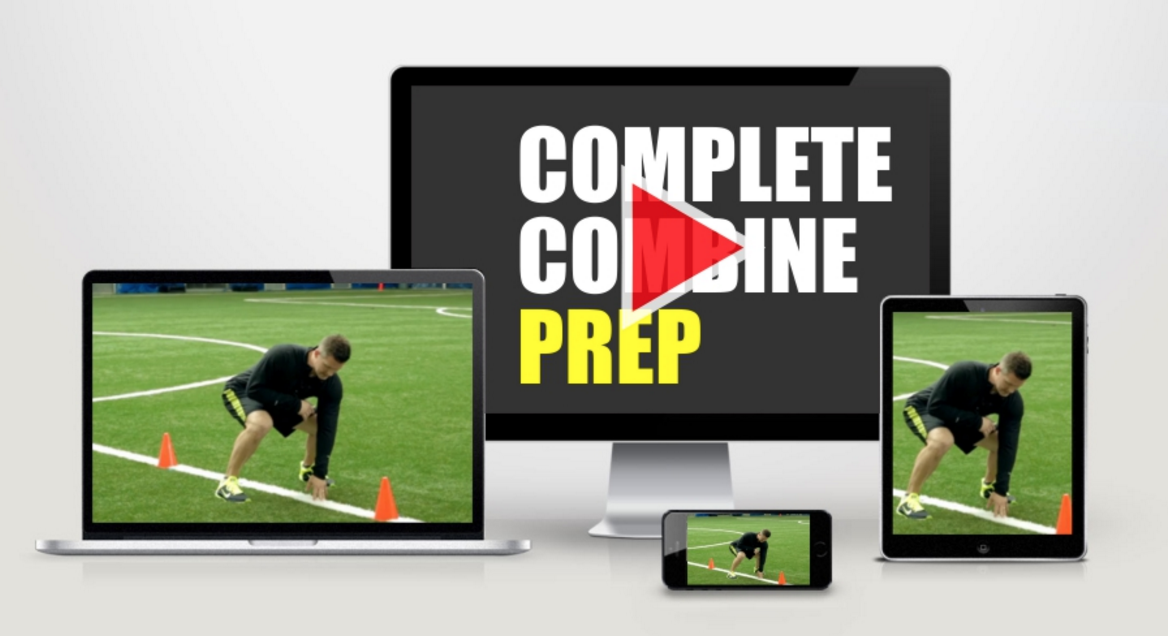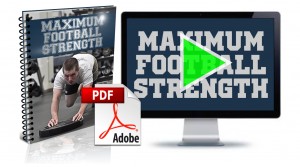Football Speed – 7 Tips to a Faster 40 (Part 2)
By: Patrick Beith

In Part I the focus was entirely on the start. Getting in best position possible to start will set up your entire 40 yard run. Now, let's get you that blazing speed you have looking for during the actual run of the 40.
Part II
Tip 1 – Drive Phase – Don’t force yourself to ‘stay low’
The drive phase happens right after you react to the starting gun. Your initial 8 -10 steps is considered your drive phase. The biggest problem seen with athletes in the drive phase is that they know that staying low will create better exit angles set-up the ideal acceleration phase. The problem is that athletes are 'trying' to stay low.
When athletes try and stay low they normally hold themselves down by breaking at the hips. This will limit the amount of force you can apply to the ground and leads to poor acceleration. Let your upper body unfold naturally. You want to keep a straight line from your back ankle all the way to your head. ‘Staying low’ will occur naturally if you are already strong enough.
Other cues:
- Drive out so the body is at a 45 degree angle to the ground.
- Keep the heel recovery low during the first 6-8 strides.
- Step over the opposite knee and drive the foot down into the ground to create maximal force.
Tip 2 – Acceleration Phase
Since the acceleration phase (0-30 yards) is associated with a higher stride frequency then at maximum speed, athletes are concerning themselves too much trying to be quick with their legs. So, instead of trying to drive out and be powerful, athletes are 'spinning their wheels'.
Make sure when you are running the 40 that you getting triple extension (ankle, knee, hip) and that you 'feel your feet behind you'. If you are getting the sensation of your feet driving well behind your center of mass, then you know you are finishing off your leg drive to be as powerful as possible. If you try to be to quick with your legs, you will not be using your full strength to drive out and although you might feel a little faster because your legs are moving quicker, you will actually have a slower time and not set yourself up to be in the best possible position.
Tip 3 – Relaxation
One of the hardest things about running is trying to stay relaxed while you run. Most athletes first think that in order to run fast that they have to run hard. They associate running hard with trying to create as much tension as possible. You can tell easily if an athlete is too tense, just by looking at their facial expression.
If you see an athlete with a tight face, their eyes will be squinting, teeth are mashed, and you know that they are trying too hard and are forcing themselves to be slow down. If you see an athlete with their cheeks flopping up and down as they run, you know that they have mastered the relaxation technique and are getting the most out their sprinting.
I remember sprint coach guru Charlie Francis saying that you must 'let the speed come'. You have to let your muscles work for you and not against to maximize your speed potential. This is a tough concept to learn and MUST be practiced if you want get the most out of our speed.
Other things to look for if you are running tight are clenched fists, elevated shoulders and a shortened stride.
Tip 4 – Arm Action
Arms should remain at approximately 90 degrees from the elbow. The angle will close at the top and open at the back (60-140 degrees) but the average is about 90 degrees. Make sure that you are not locking your arms 90 degrees, this will cause tightness and decrease your range of motion.
• Palms and fingers are relaxed and facing in
• Drive the elbows down and back to generate elastic response
• Range of motion – hip to ear
Also, make sure that the arms are not crossing the midline of your body. The arms are counteracting the force created by the legs. So, if you arms are going side to side you know that your hips will be turning because your legs are driving side to side. You want to be traveling in a linear direction with as little deviation as possible.
Tip 5 – Hands: Open vs. Closed
Cueing the hands can be a touchy subject. Some coaches believe that having your hands open is the best way while others like a closed hand for their athletes to use while running.
First, I would look at the athlete. If they look as if their shoulders/arms are staying relaxed and aren’t crossing the midline then you shouldn't cue this athlete too much with hand technique. There are so many other cues and techniques to work on then to worry about their hands if they don’t seem to be causing a problem.
If your athlete is not staying relaxed in their arms and shoulders then I would address then hands. Usually if the hands are wide open with the fingers and palms are straight, the forearm tends to be flexed. This causes tension of the arm and the upper arm and shoulders, and as you know, this can affect the elasticity of your muscles causing you to fight yourself as you move. The same thing can happen when you make a fist and try to run. Holding your hands clenched causes your forearms to be tight and you will run into the same problem as the 'open' hand.
I teach in between both of these. You want your hands to stay relaxed. I'm sure you have heard this saying before to ' pretend you are holding a potato chip in your hand and you don't want to break it'. You can actually feel your fingers almost bouncing up and down as your run. This is the type of relaxation that should carry to the rest of your arm up to your shoulder. Keep the hands loose, but not open.
Another thing to note is that looking at the top receivers and defensive backs, they never run with closed hands because they want their hands to be as soft as possible to catch a ball. If their hands are closed, their arms will be tight and it will take more time to open them and create the soft hands that they are looking for.
Tip 6 – Stride Length
We touched a little on stride frequency, now let's get into stride length. Your optimal stride length should be about 2.5-2.7 times your leg length (measured from the crest of your greater trochanter to the floor).
While optimal stride length is important, I would stay away form certain exercises to try to increase it. Excessive downhill and over speed running can actually cause problems with your running technique. If the slope going downhill is too much and if you are being pulled fast during over speed work, your legs starts to create a braking action. This is where your foot plantar flexes (toes pointed down) in front of your center of mass to try and stop that speed. So, you are fighting yourself and stopping any speed you are trying to create. This can not only cause damage to your hamstrings but can also create neuromuscular integration problems.
Flexibility (dynamic ranges of motion and static stretching) and strength & power training (which also helps joint stabilization) are the best ways to reach your optimal stride length level.
Tip 7 – Other Sprinting Tips/Cues
- Hips tall
- Foot strikes on forefoot- and under the center of mass
- Ankle steps over the knee
- Shoulders down and relaxed
- Face and neck relaxed
- Tight stomach, flat back, hips forward
- The foot hits the ground a short distance in front of the center of mass, the farther away the foot strikes away from the COM, the higher the braking force.
- toe up – reduces hamstring fatigue by using the gastroc as a knee flexor
- heel up
- knee up
Recommended Athletes' Acceleration
Products




0 Comments for “Football Speed – 7 Tips to a Faster 40 (Part 2)”